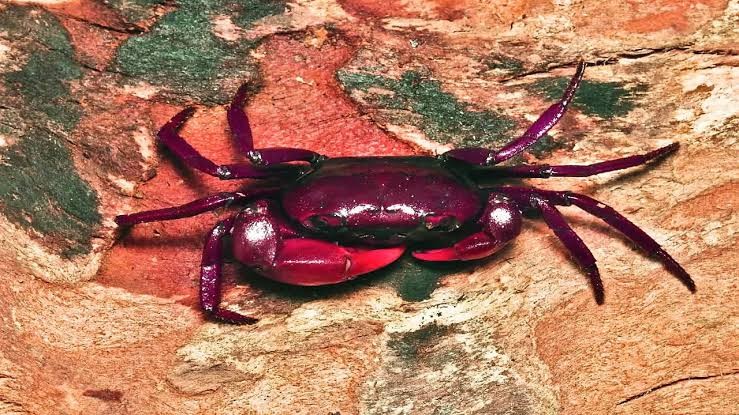
Ghatiana sanguinolenta

23.10.2023
Ghatiana sanguinolenta , Daily Current Affairs , RACE IAS : Best IAS Coaching in Lucknow
|
For Prelims: Ghatiana sanguinolenta,Features For mains GS paper 3: Western Ghats,Middle Sahyadri (Central Western Ghats),Committees for Western Ghats |
Why in the news?
Researchers recently discovered a freshwater crab species, ‘Ghatiana sanguinolenta’ from the Balekoppa village of Sirsi district in northern Karnataka.
About Ghatiana sanguinolenta:
- It is a newly discovered species of freshwater crab.
- The crab gets its name from the Latin word ‘sanguinolenta’, meaning ‘red’ or ‘blood-coloured’.
- The crab’s blood-red colour and the outwardly curved article of the first part of the male ‘gonopod’ (genetalia) distinguish it from other species in the Ghatiana subgenus.
- It is currently known only from the type locality, which is situated in the Central Western Ghats of India.
Features:
- It is about 1.1 inches wide and about 0.7 inches long.
- It has a “broad,” “strongly arched” body and small eyes.
- Its body has a rich and relatively uniform burgundy red colouring, while the tips of its claws are a lighter cherry red.
- It predominantly resides in water collected within tree trunks and exhibits heightened activity during the rainy season.
- Their diet consists of insects and algae.
- Male and female crabs share the same coloration.
The Western Ghats
- The subduction of the Arabian basin and the tilting of the peninsula in the east and northeast during the Himalayan uplift generated the Western Ghats.
- The Western Ghats are a 1600 km long mountain chain along the west coast of India running from the river Tapi in the north to Kanyakumari in the south.
- They pass through States of Gujarat, Maharashtra, Goa, Karnataka, Kerala and Tamil Nadu (6 in number). They are known by various regional names like Sahyadri, Nilgiris etc.
- Western Ghats have a tropical humid climate .The western side of the Ghat receives more rainfall than the eastern side due to windward effect.
- Western Ghats was declared as a world heritage site in 2012 by the United Nations Education, Scientific and Cultural Organisation (UNESCO).
- It spans all the way from Tapi Valley to Kanyakumari. It is known as Sahyadri till 11° N.
- It is divided into three pieces.
Northern Western Ghats
Middle Sahyadri(Central Western Ghats)
Southern Western Ghats
Middle Sahyadri (Central Western Ghats)
- The Middle Sahyadri range stretches from 16°N latitude to the Nilgiri hills.
- This section is composed of granites and gneisses.
- The surrounding region is densely forested.
- Headward erosion of west-flowing streams has significantly fragmented the western scarp.
- The average elevation is 1200 meters, although numerous peaks reach 1500 meters.
- Important peaks are the Vavul Mala (2,339 m), Kudremukh (1,892 m), and Pashpagiri (1,714 m).
- The Nilgiri Hills, which connect to the Sahyadris around the tri-junction of Karnataka, Kerala, and Tamil Nadu, rise suddenly to above 2,000 meters.
- They are the meeting point of the Western and Eastern Ghats.
- This area's most notable peaks are Doda Betta (2,637 m) and Makurti (2,554 m).
- It has a granitic structure and is located in the Central Western Ghats.
- Mullayanagiri on Baba Budan Hill is Karnataka's highest peak. This segment has developed nick spots as well as waterfalls such as Gersoppa/jog Falls across the Sharavathi River.
- This portion is distinguished by two separate features: Malnad, which are hills, and Maidan, which are plateau surfaces.
- The river Kaveri comes from the Brahmagiri Hills, and the lake is known as Talakaveri Lake.
Conservation Efforts for Western Ghats
Committees for Western Ghats:
Gadgil Committee (2011): Also known as the Western Ghats Ecology Expert Panel (WGEEP), it recommended that all of the Western Ghats be declared as the Ecological Sensitive Areas (ESA) with only limited development allowed in graded zones.
Kasturirangan Committee (2013): It sought to balance the development and environment protection in contrast to the system proposed by the Gadgil report.
○The Kasturirangan committee recommended that instead of the total area of Western Ghats, only 37% of the total area should be brought under ESA and a complete ban on mining, quarrying and sand mining be imposed in ESA.
Source:Times of India